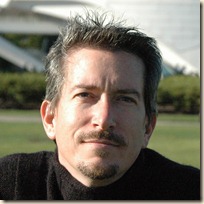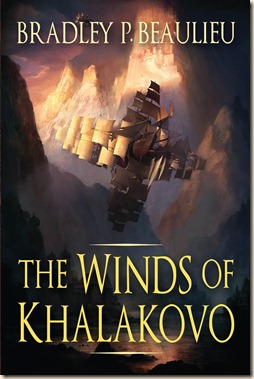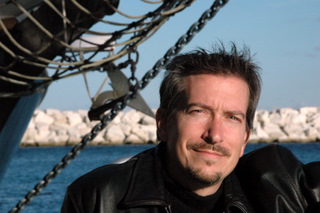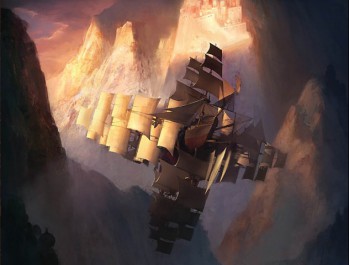An Interview with Author Bradley Beaulieu
 I’m pleased to interview my great friend and writer buddy, Brad Beaulieu. We’ll be discussing his new novel, The Winds of Khalakovo, Book One of The Lays of Anuskaya, which comes out the first of April 2011 from Nightshade Books as a trade paperback and as an eBook. Winds is a sweeping epic fantasy with a Czarist Russian and Persian feel, a unique combination to be sure. I’m so proud of Brad’s accomplishment with the world building and the story. I’ve been involved with this novel for several years now, and have had a part in the revisions, so I’ve seen it go from an awesome book with an amazing concept to a truly exceptional one with a fully fleshed-out world.
I’m pleased to interview my great friend and writer buddy, Brad Beaulieu. We’ll be discussing his new novel, The Winds of Khalakovo, Book One of The Lays of Anuskaya, which comes out the first of April 2011 from Nightshade Books as a trade paperback and as an eBook. Winds is a sweeping epic fantasy with a Czarist Russian and Persian feel, a unique combination to be sure. I’m so proud of Brad’s accomplishment with the world building and the story. I’ve been involved with this novel for several years now, and have had a part in the revisions, so I’ve seen it go from an awesome book with an amazing concept to a truly exceptional one with a fully fleshed-out world.
Brad has had his short stories published in the most prestigious speculative fiction publications including Realms of Fantasy, The Intergalactic Medicine Show, Writers of the Future, and several anthologies from DAW Books. He’s also the father of two and the husband to a wonderful woman, Joanne. They live in Wisconsin and besides being an excellent writer, Brad is an amazing cook.
Now on to the interview…
An Interview with Bradley Beaulieu
Conducted and Transcribed by Paul Genesse
Congratulations on Winds. You deserve the praise and acclaim so much, and I’m really happy for you.
Thanks so much, Paul. And thanks for having me for the interview. It’s a lot of fun talking about the book now that it’s out in the world.
For me, with writing, it’s all about the characters, and you’ve got three amazing characters in Winds who drive the plot. You’ve got Prince Nikandr Khalakovo, the main protagonist; Rehada, his Aramahn lover who is also a spy and worse; and Atiana Vostroma, Nikandr’s betrothed, who arrives to cement a much-needed political marriage. Why did you decide to use three characters, and which one did you have the most fun writing?
I actually started with only two: Nikandr and Atiana. I was telling the tale through the eyes of the Landed, the people that rule the islands. But what I found was that revealing other aspects of the story, particularly those that needed to be viewed through the eyes of the peaceful Aramahn, were too difficult to tell without another viewpoint. I was starting to perform all sorts of literary gyrations just to get those parts of the story onto the page, so adding a new character became the perfect solution.
I loved delving into all three characters for different reasons, but as for which one I had the most fun writing, it would have to be Nikandr. He was the one I identified with the most, partly because he was male, but also — and I’ll be frank here — I had a hell of a time writing the fight scenes. Although I don’t shy away from physical scenes with the female characters, Nikandr gets the lion’s share of them, and writing about windship battles, musket fire, and detailing the sword fights through Nikandr’s eyes was great fun.
 What makes Prince Nikandr so interesting? Tell us about where he began as a character and who he became as you wrote the book.
What makes Prince Nikandr so interesting? Tell us about where he began as a character and who he became as you wrote the book.
One of my favorite things about the people of the Grand Duchy, especially those of royal blood, is that they value family above nearly everything else. Religion isn’t organized in the world of Erahm, but if the people of the Grand Duchy have any religion at all it is embodied in the notion that those that have come before care for those that come after. The term “the ancients” is used throughout the book, and it embodies this notion: that one’s ancestors seek to protect from beyond the grave.
I like to think that each of the Duchies embraces this notion, sometimes to the detriment of the Grand Duchy as a whole. They squabble with one another, they even fight, all with this notion of protecting their family. There are marriages between the royal families, and so loyalties that seem straightforward become complex when you consider where wives were raised, where their families come from and still live. Things get muddy quickly.
The thing I like about Nikandr is that in a way he is the embodiment of these ideals. He loves his family, and yet he wants to honor Atiana and his new family. And of course there is a major wrench thrown into the works in the form of Rehada — not only is she not of royal blood, she is one of the Aramahn.
Nikandr, like so many of the Landed people, struggles with the choices he is forced to make with respect to the political struggles that have been brewing, but also over what to do with the boy, Nasim. On the one hand, he thinks Nasim is someone who should be protected and who may come to help the Grand Duchy. On the other hand, there are clear indications that Nasim was involved with something terrible that happened on Khakovo’s shores.
It was a delicious mix to put Nikandr in. He’s the probably the least conflicted of the three main characters, but he has some very tough choices he has to make. This, in the end, is where I like characters to be. I want them to be in positions where the choices that lie before them are neither attractive nor clean.
Rehada, Nikandr’s Aramahn lover is my favorite character in the book. She’s a very conflicted character. She’s a courtesan, a mother, a spy, and worse. Plus she’s a wielder of powerful fire magic, a woman who can control fire elementals. How did you manage to craft such an intriguing character? How does she manage to sizzle on the page?
 While Nikandr is the character I identify with the most, I will admit that Rehada became my favorite character as well. Both her and Soroush. Why? Because they are complex, and they had the most surprises for me along the way. This has as much to do with their culture as it does them as characters. While I was brainstorming the world and the cultures of the Aramahn (who are peace-loving) and the Maharraht (a splinter group of the Aramahn who have forsaken their peace-loving ways to wage war on the Landed), I came to a crossroads. I couldn’t quite reconcile how the Maharraht could have drifted so far from one of the central tenets of their religion: do no harm to others.
While Nikandr is the character I identify with the most, I will admit that Rehada became my favorite character as well. Both her and Soroush. Why? Because they are complex, and they had the most surprises for me along the way. This has as much to do with their culture as it does them as characters. While I was brainstorming the world and the cultures of the Aramahn (who are peace-loving) and the Maharraht (a splinter group of the Aramahn who have forsaken their peace-loving ways to wage war on the Landed), I came to a crossroads. I couldn’t quite reconcile how the Maharraht could have drifted so far from one of the central tenets of their religion: do no harm to others.
The Aramahn and Maharraht, though they borrow greatly from Persian culture, draw more upon Buddhism for their religious beliefs. They believe in reincarnation and they strive for enlightenment — if not in this life, then hopefully the next. When I was looking at the artwork I was using to represent Rehada’s character, it occurred to me that the tear on her cheek came from some profound disappointment in herself. I continued working that thread, and I realized—it was one of those lightning bolt moments—that she was disappointed because she had betrayed her beliefs. It was from that single tear that the Maharraht were truly born. They see themselves as sacrificing themselves and their path to enlightenment so that the rest of their people — the Aramahn — won’t have to.
This, I think, is the primary reason Rehada leaps off the page. She’s very conflicted, and from that comes tension that’s hard to look away from.
Atiana, Nikandr’s betrothed turns out to be the biggest surprise of the novel for me. She ends up being such a strong character who makes tough decisions and owns them. I think it’s rare to have two incredibly strong female protagonists in a novel. Tell us about Atiana and tell us how her character evolved as you drafted the book.
Yeah, Atiana was a lot of fun as well. She’s a princess, one of three triplets, and she comes from a rather sheltered world. Her other two sisters have already been married away. She, the youngest by minutes, is being married to Nikandr to cement the increasingly strained relationship between the Anuskaya’s two most powerful duchies. Shortly after arriving on Khalakovo for her impending marriage, she is thrust along with everyone else into the mystery surrounding the death of the Grand Duke. But Atiana wasn’t really ready for this. She’s unprepared for these challenges, so it was interesting for me to see her grow, to rise to the occasion.
She is also our link to the aether, the stuff that lies between the material and spiritual planes. She is asked to become a Matra, one who submerges herself into frigidly cold water to slip into a trancelike state and reach “the dark,” as it’s known. This was one of the most interesting aspects of the world, the ability of the landed women to navigate the dark to communicate over long distances and to keep a watchful eye on their Duchy for the presence of the Maharraht. And Atiana is the window through which we view that world-within-a-world. It was great fun writing those scenes, but even greater fun seeing Atiana blossom and rise above her role as “youngest.”
How did you psychologically handle the revisions to this book? It went through many different layers, and the beginning scenes changed so many times. How did you deal with all of this and how did you not go freaking insane?
Seriously, though, I did go through a lot of changes and drafts. Not Pat Rothfuss numbers, mind you, but quite a few just the same. I’ve written larger books before, but this one was the largest by far, and it’s an indicator of how deep and wide the world is. I realized as I was starting to write just how much I loved the world and the characters, and I tried to be careful to keep my mind open to cool, new, exciting things that I could add to enrich it. I didn’t just grab anything that came to mind, but I did “try things on for size” quite often. If they fit, I kept them. If not, I tossed them. But it made for a story that changed fairly significantly from first to final draft.
By the third or fourth draft, I had a pretty good idea of what this story was. Things were grounded by then, so it was just a matter of polishing the story as much as I could before submitting.
Twelve-masted wind ships!? How did you come up with the idea for them? I love that they sail through the sky with the Aramahn controlling elemental wind spirits and the ships have masts poking out in four directions — not to mention the cannon and muskets. The book cover really captures the ship so well.
Well, the windships came while I was brainstorming the world itself. The Grand Duchy is comprised of nine archipelagos, each one of them a single Duchy. Centuries ago the only people that visited the miserably cold islands were the Aramahn, who traveled the world on simple skiffs. Eventually, though, the people of Yrstanla—the only large continent on the planet—followed the Aramahn. They adopted their ships, and modified them for their own use. They made them larger, more able to carry cargo and — eventually — weapons.
The skiffs of the Aramahn were more traditional “ships of the sky” that you see in classic literature. They had a hull and a single mast that the wind masters use to harness the winds and travel as they will. But I’d always been bothered by the larger flying ships modeled after the age of sail. The physics would never work, and so I found myself trying to find a new design, and it occurred to me that they would use sails in all directions, not just above. I have all sorts of things worked out as to how they work, like how the “rudder” captures the ley lines of the islands to align the ship a certain way, but my geek meter is starting to peg red, so I think I’ll quit while I’m ahead. For me, though, these ships were a neat twist on a familiar theme. I’m glad they made it onto the cover.
The climax of the novel builds to an amazing pitch. I greatly admire how it all came together. Did you spend forever figuring out how to put all of that together? How hard was constructing the ending?
 Actually the ending was not nearly as hard as the middle. It’s not called the muddle in the middle for no reason. It’s somewhat easy to take the threads you’ve shown to the reader in the beginning and complicate them so that there are more. The story begins to expand like a point in time expanding to a “cone” of possibilities. The tough part comes when you have to start pulling those threads in. (Here the cone starts to draw in to more of a football shape.) You have to begin preparing for the end of the book pretty early on in the process or you’ll find that too many things are going too far afield. If you don’t watch it, you’ll have a gnarled mess of mismatched threads instead of a tapestry.
Actually the ending was not nearly as hard as the middle. It’s not called the muddle in the middle for no reason. It’s somewhat easy to take the threads you’ve shown to the reader in the beginning and complicate them so that there are more. The story begins to expand like a point in time expanding to a “cone” of possibilities. The tough part comes when you have to start pulling those threads in. (Here the cone starts to draw in to more of a football shape.) You have to begin preparing for the end of the book pretty early on in the process or you’ll find that too many things are going too far afield. If you don’t watch it, you’ll have a gnarled mess of mismatched threads instead of a tapestry.
So as I do start to narrow the possibilities and point the story generally toward the end, it starts to resolve itself like an image in the mist. Then it’s just a matter of tying up all the threads. No easy thing, but it’s still easier than the middle. The middle can bite my ass.
Now, to the most important question: when is book two coming out and what is it called? Can you give us a teaser about it?
The second book is called The Straits of Galahesh. It begins five years after the events of The Winds of Khalakovo. I don’t want to get too spoilery, but I think it’s safe to talk about how the story widens. The islands of the Grand Duchy, where the events portrayed in Winds take place, are situated near a larger continent, the motherland of Yrstanla. The empire there that has been at peace with Anuskaya for generations. However, trouble begins brewing as the Empire sets its sights once again on the islands they once ruled.
The next book still takes place largely throughout the islands of the Grand Duchy, but we begin to explore the Empire and its peoples and customs. We also learn more about Nasim’s mysterious past. In the third book, this trend continues. The story moves onto the mainland itself as the characters, once and for all, try to deal with the source of the blight and the terrible wasting disease.
Download the first fifteen chapters of The Winds of Khalakovo for free here, and enjoy riding the wind.
Paul Genesse is the editor of The Crimson Pact eBook anthology and the author of the Iron Dragon Novels.
